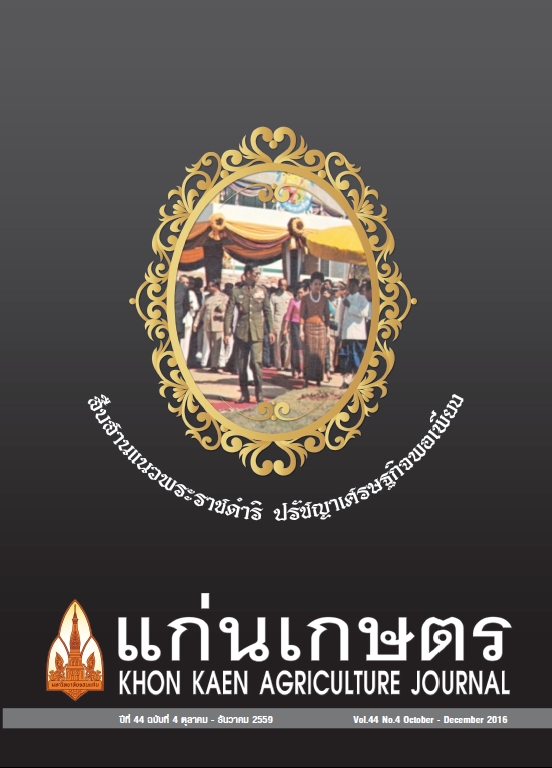ผลของอาหารที่มีต่อศักยภาพในการสืบพันธุ์และความรุนแรงในการเข้าทำลายเหยื่อของไส้เดือนฝอยศัตรูแมลง
Main Article Content
บทคัดย่อ
หนึ่งในปัจจัยที่มีผลต่อศักยภาพในการสืบพันธุ์และประสิทธิภาพในการเข้าท�าลายเหยื่อของไส้เดือนฝอยศัตรูแมลงคือความอุดมสมบูรณ์ของอาหาร ดังนั้นการทดลองนี้จึงมีวัตถุประสงค์เพื่อศึกษาผลของอาหารเลี้ยงไส้เดือนฝอยศัตรูแมลงต่อจ�านวนลูกและค่าความเป็นพิษแบบเฉียบพลันของไส้เดือนฝอยศัตรูแมลง (The median lethal dose; LD50) จ�านวน 7 ชั่วรุ่น วางแผนการทดลองแบบสุ่มสมบูรณ์ (Completely Randomized Design: CRD) มี 3 กรรมวิธีดังนี้ กรรมวิธีที่ 1 อาหารเทียมสูตรกรมวิชาการเกษตร กรรมวิธีที่ 2 อาหารเทียมวุ้น (Nutrient-agar media) และกรรมวิธีที่ 3 เลี้ยงเพิ่มปริมาณบนตัวแมลง (In vivo) ผลการทดลองพบว่า ไส้เดือนฝอยศัตรูแมลงที่เลี้ยงด้วยอาหารเทียมวุ้นสามารถให้จ�านวนลูกในรุ่นที่ 1 และ 2 สูงกว่ากรรมวิธีอื่น โดยมีจ�านวนลูกเฉลี่ยอยู่ที่ 61.81 และ 62.20 ตัว/พ่อแม่ 1 คู่ ตามล�าดับ เมื่อท�าการเลี้ยงผ่านไป 3 - 7 รุ่น พบว่าไส้เดือนฝอยศัตรูแมลงที่เลี้ยงบนตัวแมลงมีแนวโน้มจ�านวนลูกสูงกว่ากรรมวิธีอื่นอย่างมีนัยส�าคัญ ค่าเฉลี่ยความเป็นพิษของไส้เดือนฝอยศัตรูแมลงที่เลี้ยงบนตัวแมลง (LD50) ในลูกทั้ง 7 รุ่น มีค่าต�่าที่สุดอยู่ที่ 45.97 ตัว/แมลงอาศัย รองลงมาคือ กรรมวิธีที่เลี้ยงด้วยอาหารเทียมวุ้น (53.18 ตัว/แมลงอาศัย) และสูตรอาหารกรมวิชาการเกษตร (53.47 ตัว/แมลงอาศัย) ผลจากการทดลองนี้แสดงให้เห็นว่า คุณภาพและประสิทธิภาพของอาหารที่เลี้ยงมีผลต่อศักยภาพในการสืบพันธุ์และความรุนแรงในการเข้าท�าลายเหยื่อของไส้เดือนฝอยศัตรูแมลงในระยะไม่กี่ชั่วรุ่นเท่านั้น การพัฒนาเทคนิคเพื่อคงสภาพลักษณะเด่นที่ต้องการนั้นจ�าเป็นต้องได้รับการศึกษาเพิ่มเติมในอนาคต
Article Details

อนุญาตภายใต้เงื่อนไข Creative Commons Attribution-NonCommercial-NoDerivatives 4.0 International License.
เอกสารอ้างอิง
ประกายจันทร์ นิ่มกิ่งรัตน์, นุชรีย์ ศิริ และจันทร์เพ็ญ ชาดาเม็ก. 2556. ประสิทธิภาพไส้เดือนฝอยศัตรูแมลงในการป้องกันกำจัดแมลงหวี่ขาวในพริก. แก่นเกษตร. 42(2): 255-264.
Abu Hatab, M., R. Gaugler, and R.-U. Ehlers. 1998. Influence of culture method on Steinernema glaseri lipids. J. Parasitol. 84: 215-221.
Abu Hatab, M., and R. Gaugler. 2001. Diet composition and lipids of in vitro - produced Heterorhabditis bacteriophora. Biological Control. 20: 1-7.
Akhurst, R.J. 1982. Antibiotic activity of Xenorhabdusspp., bacteria symbiotically associated with insect pathogenic nematodes of the families Heterorhabditidae and Steinernematidae. J. Gen. Microbiol. 128: 3061-3065.
Bai, C., D. Shapiro-Ilan, R. Gaugler, and K.R. Hopper. 2005. Stability of beneficial traits in Heterorhabditis bacteriophora through creation of inbred lines. Biological Control. 32(2): 220-227.
Bilgrami, A., R. Gaugler, D. Shapiro-Ilan, and B. Adams. 2006. Source of trait deterioration in entomopathogenic nematodes Heterorhabditis bacteriophora and Steinernema carpocapsae during in vivo culture. J. Nematol. 8: 397-409.
Burman, M. 1982. Neoaplectana carpocapsae:Toxin production by axenic insect parasitic nematodes. Nematologica. 28: 62-70.
Burnell, A. 2002. Genetics and genetic improvement. In: Gaugler R. (ed.). Entomopathogenic Nematology. CABI International, Wallingford, UK, pp. 241-263.
Ehlers, R.-U. 2001. Mass production of entomopathogenic nematodes for plant protection. Applied Microbiology and Biotechnology. 56: 623-633.
Elawad, S.A., S.R. Gowen, and N.G.M. Hague. 2001. Progeny production of Steinernema abbasi in lepidopterous larvae. Int. J. Pest. Manage. 47: 17-21.
Epsky, N.D., and J.L. Capinera. 1993. Quantification of invasion of two strains of Steinernema carpocapsae(Weiser) into three lepidopteran larvae. Journal of Nematology. 25: 173-180.
Friedman, M.J., S.E. Langston, and S. Pollitt. 1989. Mass production in liquid culture of insect-killing nematodes. International Patent Application, WO 89/04602.Gaugler, R., and H.K. Kaya. 1990. Entomopathogenic Nematodes in Biological Control. CRC Press, Inc., Boca Raton, Florida, pp. 365.
Georgis, R., A.M. Koppenhofer, L.A. Lacey, G. Belair, L.W. Duncan, P.S. Grewal, M. Samish, L. Tan, P. Torr, and R.W.H.M. van Tol. 2006. Successes and failures in the use of parasitic nematodes for pest control. Biological Control. 38: 103-123.
Glazer, I., and E.E. Lewis. 2000. Bioassays of entomo-pathogenic nematodes. In: Navon A. and Ascher K.R.S. (eds.). Bioassays of entomopathogenic microbes and nematodes. CAB International, Wallingford, UK, pp. 229-248.
Grewal, P.S., R.-U. Ehlers, and D. Shapiro-Ilan. 2005. Nematodes as biological control agents. CAB International, Wallingford, UK, pp. 505.
Grewal, P.S., S. Bornstein-Forst, A.M. Burnell, and I. Glazer. 2006. Physiological, genetic, and molecular mechanisms of chemoreception, thermobiosis, and anhydrobiosis in entomopathogencic nematodes. Biological Control. 38: 54-65.
Hara, A.H., J.E. Lindegren, and H.K. Kaya. 1981. Monoxenic mass production of the entomogenous nematode Neoaplectana carpocapsae Weiser on dog food/agar medium. USDA Advances in Agriculture W-16: 8 pp.
Islas-Lopez, M.A., R. Sanjuan-Galindo, A.I. Rodriguez-Hernandez, and N. Chavarria-Hernandez. 2005. Monoxenic production of the entomopathogenic nematode Steinernema carpocapsae using culture media containing agave juice (aguamiel) from Mexican maguey-pulquero (Agave spp.). Effect of the contents of nitrogen, carbohydrates and fat on infective juvenile production. App. Micro. Biotech. 68: 91-97.
Kaya, H.K., and R. Gaugler. 1993. Entomopathogenic nematodes. Ann Rev Entomol. 38: 181-206.
Nimkingrat, P., S. Khanam, O. Strauch, and R.-U. Ehlers. 2013a. Hybridisation and selective breeding for improvement of low temperature activity of the entomopathogenic nematode Steinernema feltiae. BioControl. 58(3): 417-426.
Nimkingrat, P., O. Strauch, and R.-U. Ehlers. 2013b. Hybridisation and genetic selection for improving desiccation tolerance of the entomopathogenic nematode Steinernema feltiae. Biocontrol Sci Techn. pp. 348-361.
Segal, D. and I. Glazer. 2000. Genetics for improving biological control agents: the case of entomopathogenic nematodes. Crop Protection. 19: 685-689.
Shapiro-Ilan, D., J.R. Cate, J. Pena, A. Hunsberger, and C.W. McCoy. 1999. Effects of temperature and host range on suppression of Diaprepes abbreviatus(Coleoptera: Curculionidae ) by entomopathogenic nematodes. J. Eco. Ent. 92: 1086-1092.
Shapiro-Ilan, D., and R. Gaugler. 2002. Production technology for entomopathogenic nematodes and their bacterial symbionts. JIMB. 28: 137-146.
Shapiro-Ilan, D., M. Guadalupe Rojas., J.A. Morales-Ramos, E.E. Lewis, and W.L. Tedders. 2008. Ef-fects of host nutrition on virulence and fitness of entomopathogenic nematodes: Lipid- and protein-based supplements in Tenebrio molitor diets. J. Nematol. 40(1): 13-19.
Somasekhar, N., P.S. Grewal, and M.G. Klein. 2002. Genetic variability in stress tolerance and fitness among natural populations of Steinernema carpocapsae. Biological Control. 23: 303-310.
Wang, X., and P.S. Grewal. 2002. Rapid genetic deterioration of environmental tolerance and reproductive potential of an entomopathogenic nematode during laboratory maintenance. Biological Control. 23: 71-78.
White, G.F. 1927. A method for obtaining infective nematode larvae from cultures. Science. 66: 302-303.
Wouts, W.M. 1981. Mass production of the entomogenous nematode Heterorhabditis heliothidis (Nematoda: Heterorhabditidae) on artificial media. J. Nematol. 13: 467-469.
Yoo, S.K., I. Brown, and R. Gaugler. 2000. Liquid media development for Heterorhabditis bacteriophora: lipid source and concentration. App. Micro. Biotech. 54: 759-763.


